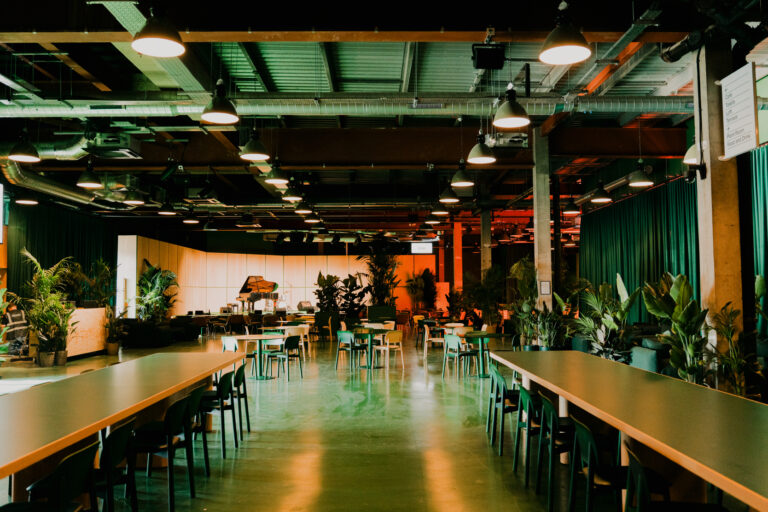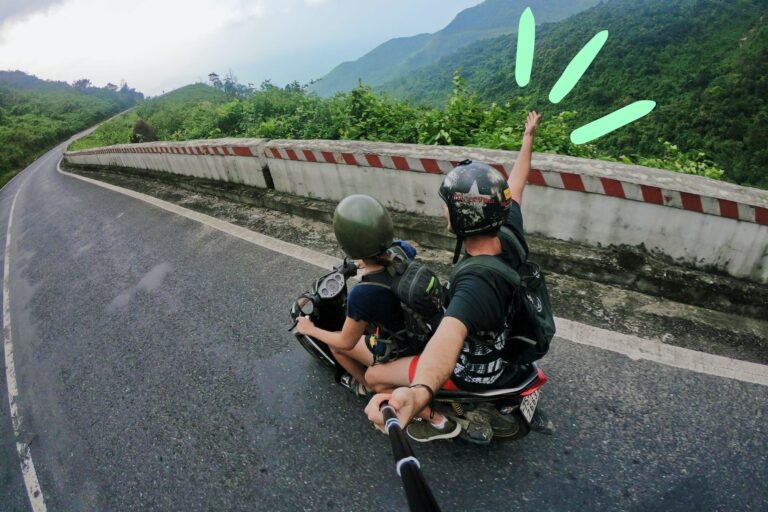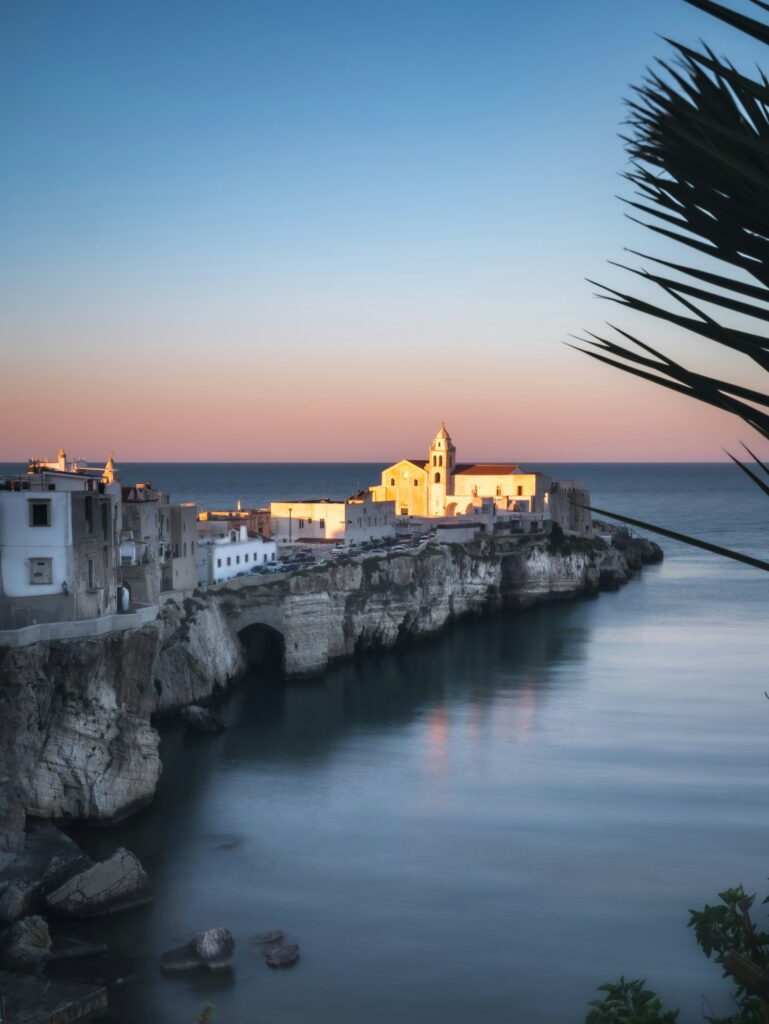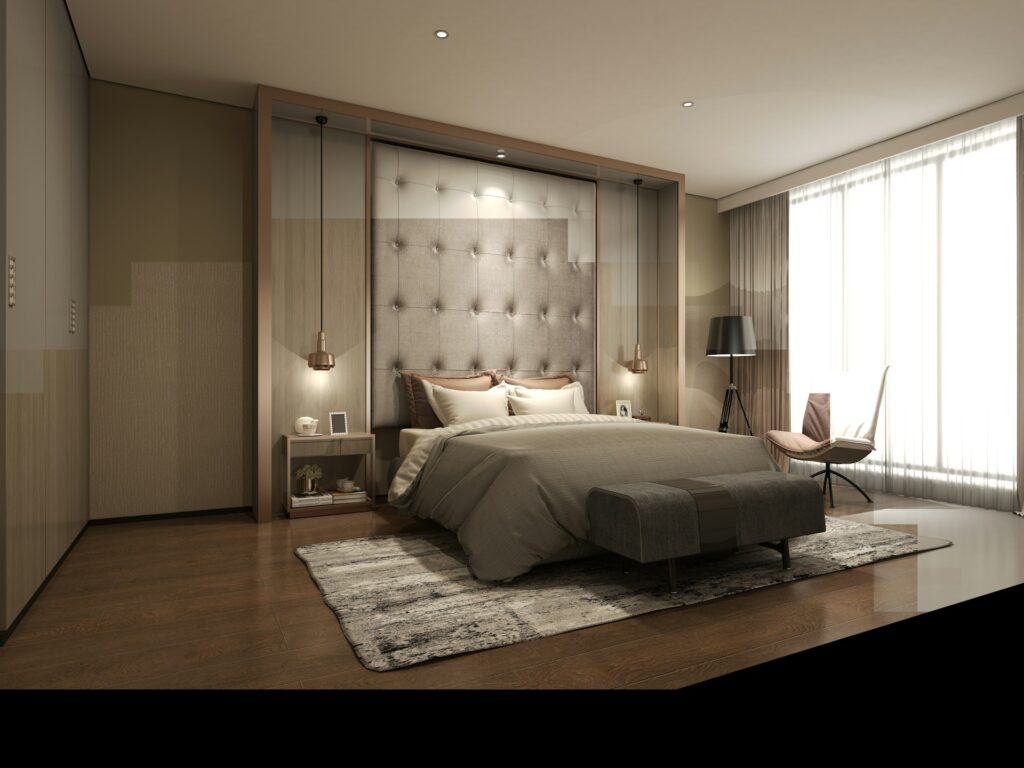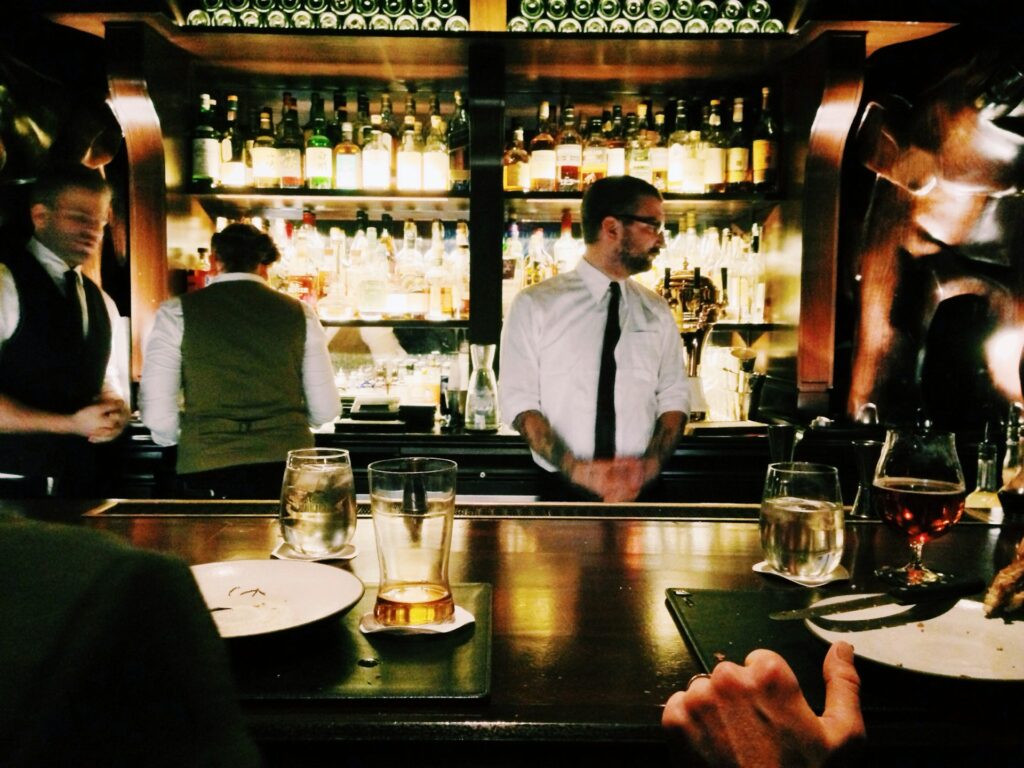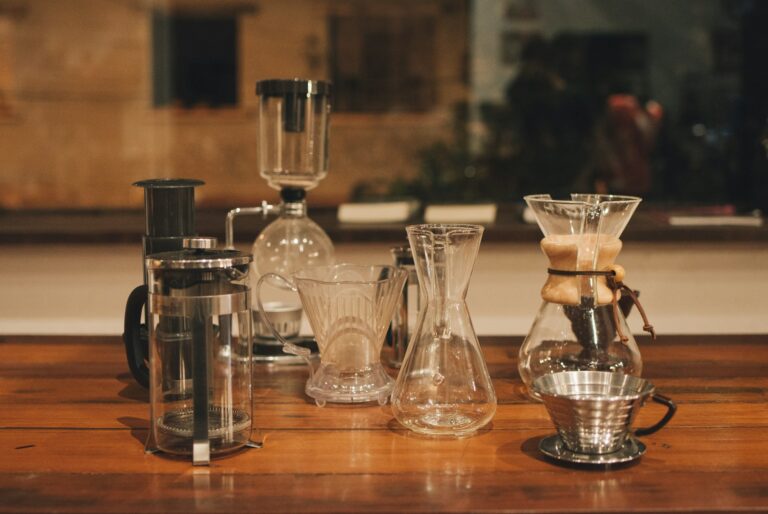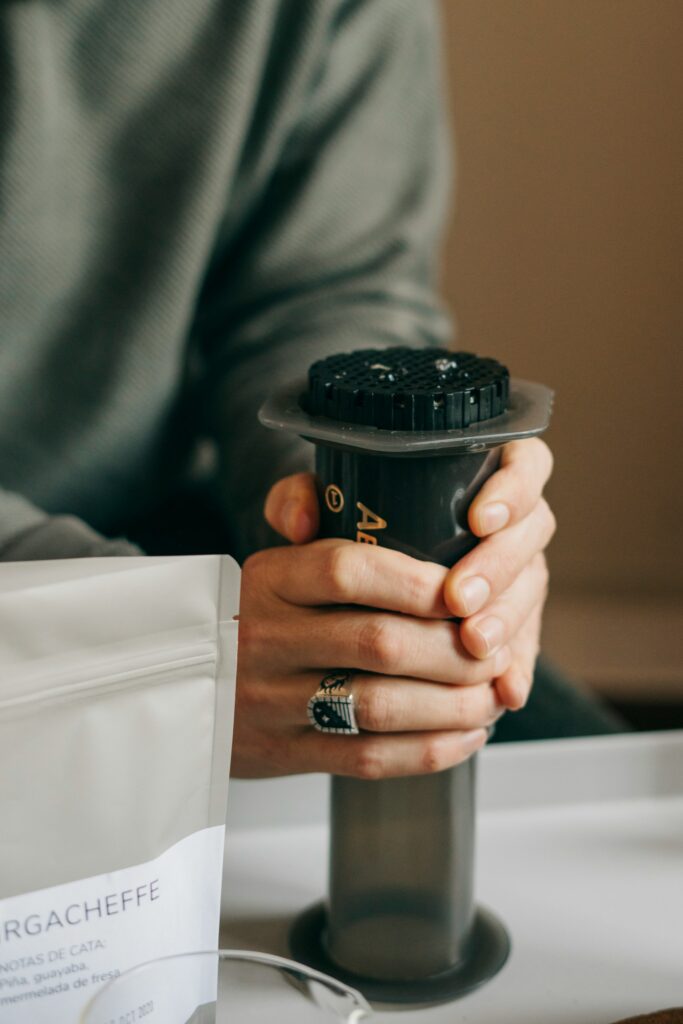Perhaps we’re stating the obvious here, but Canada Water hasn’t always been the most obvious destination for a decent meal. For years, this corner of SE16 was better known for its vast Tesco and the Jubilee line’s thunderous arrival every three minutes than for any culinary prowess. But times are changing in this former docklands neighbourhood, and fast.
With a £4 billion regeneration project in full swing and new residents flooding in faster than you can say “Overground to Shoreditch”, Canada Water has morphed from transport interchange to functioning neighbourhood. The old Surrey Commercial Docks might be long gone, but in their place, a new wave of restaurants has arrived, serving everything from Tudor-era pub grub to tacos that even a Mexico City street vendor would be proud of.
And the best bit? You’re still only 7-8 minutes from London Bridge on the Jubilee line, meaning you can feast enthusiastically without the Zone 1 premium before your onward journey. Here’s where to eat near Canada Water station and the best restaurants in the area.
The Mayflower, Rotherhithe Street
Ideal for experiencing 400 years of riverside history with your fish and chips…
You know that pub everyone bangs on about being ‘steeped in history’, when really that history (and the steeping, in fact) is just the stale aroma of ten-year old beer in the carpet? Well, The Mayflower actually is steeped in history. This isn’t some Victorian railway tavern masquerading as ancient; it’s been serving pints on this exact spot since 1550 (when it was named the Spread Eagle), back when Shakespeare was still decades away from his first soliloquy.
Standing at the very point where the Pilgrim Fathers set sail for America in 1620, The Mayflower is the oldest pub on The Thames. Perhaps even more importantly, it serves what locals swear blind are the best fish and chips in London. And having demolished a plate of their beer-battered haddock with twice-cooked chips on the creaking wooden jetty that juts out over the river, we wouldn’t bother arguing against that claim. They’ve been seasoned with history, for fucks sake!



At £19 for a portion, it’s not the cheapest in town, and the chips tend towards the anaemic at times, but you’re paying for heritage here, and for views that have barely changed since Pepys was scribbling in his diary. The steak pie, with its fat quenelle of buttery mash and pool of glossy gravy that’s the same mahogany-brown as the pub’s centuries-old beams, is hard to resist too. Or, simply have a Guinness and consider the 210 calories a light lunch.
A word of warning: that riverside jetty operates on a strictly first-come, first-served basis, and on sunny weekends, the queue can stretch back to the bar. Time your visit for a weekday lunch if you can, when you might just have the Thames to yourself, save for the occasional passing clipper and the odd ambitious cormorant.
Website: mayflowerpub.co.uk
Address: 117 Rotherhithe St, London SE16 4NF
Canada Water Cafe, Surrey Quays Road
Ideal for when you want to bookend your day with a strong coffee at 7:30am and a homemade pasta at 9:30pm…
Some restaurants try too hard to be all things to all people, and end up being none. Canada Water Cafe actually pulls it off. By day, it’s where bleary-eyed commuters grab flat whites and pastries (from St John Bakery, no less) before battling the Jubilee line. Come evening, those same formica tables get the candlelit treatment as the kitchen switches from croissant to carbonara.
Indeed, since 2014, this unassuming spot directly outside the station has been pulling off the neighbourhood’s most impressive balancing act. The transformation happens around 5pm, when the espresso machine takes a back seat to the pasta roller, the smell of a thousand fry-ups is shooed out the door, and suddenly you’re in a little Italian trattoria, complete with spent Chianti bottles on candle duty, and a flickering wood-fired oven on constant pizza rotation until close.


Don’t leave before a big wedge of tiramisu (they do actually make it fresh daily), which provides the kind of comfort usually reserved for cashmere jumpers and log fires. But really, the true comfort here is found in the space and sense of community, because Canada Water Cafe is a wonderfully welcoming, inclusive place, full of warm vibes and good energy.
Sometimes you want a croissant. Sometimes you want cacio e pepe. Here, wonderfully, you can have both. Hmmm, we’re getting an idea for a hybrid breakfast stuff…
Website: canadawatercafe.com
Address: 40 Surrey Quays Rd, London SE16 7DX
La Chingada, Rotherhithe New Road
Ideal for some of London’s best tacos…
In a corner of Surrey Quays that’s more retail park than restaurant quarter, La Chingada blazes like a piñata at a funeral.
The fact they import their soft drinks directly from Mexico (that’s that good cane sugar coming through) should tell you everything you need to know about their commitment to doing things properly. This isn’t Cal-Mex nonsense with sour cream and yellow cheese. These are tacos on corn tortillas, the kind that disintegrate if you don’t eat them fast enough, leaving you with deliciously greasy fingers and a strong desire to order more.
The birria tacos are a highlight, arriving as a glorious mess of slow-cooked lamb, the meat so tender it’s practically a paste, with a cup of spicy consommé on the side for dipping. One bite and you’ll understand why people queue here with such diligent patience.



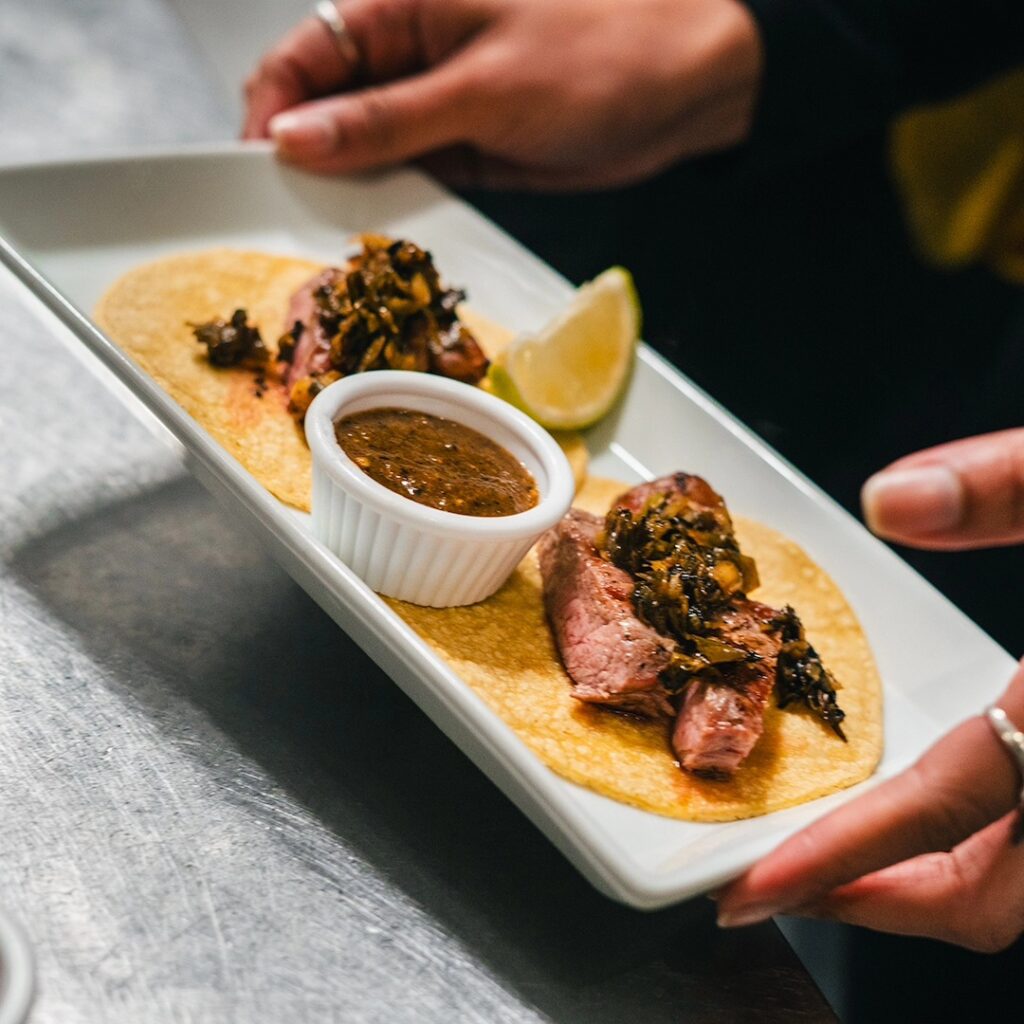
The al pastor is another winner. With its achiote-marinated pork and caramelised pineapple, it hits all the sweet-savoury notes you want, while vegetarians can console themselves with the mushroom and huitlacoche option that’s earthy and deeply satisfying. At around £8.90 for two tacos, you’ll want to order a couple of rounds. And then, quite possibly, order a couple more…
The space itself is tiny, with colourful murals, mismatched chairs, and a general air of cheerful chaos. When it’s packed (which is most evenings), you might find yourself sharing a table with strangers, but after a couple of their micheladas and a basket of air-pocketed tortilla chips with salsa verde, you won’t mind one bit.
Fair warning: they’re closed Mondays, a fact we discovered the hard way after a 40-minute journey involving two bus changes.
Website: lachingada.co.uk
Address: 12 Rotherhithe New Rd, London SE16 2AA
Read: The best Mexican restaurants in London
The Blacksmith’s Arms, Rotherhithe Street
Ideal for when you can’t decide between a Sunday roast and a pad thai…
Only in London would a Victorian pub with 1930s mock-Tudor styling serve both Yorkshire puddings and Thai green curry, and somehow make perfect sense. The Blacksmith’s Arms has been feeding Rotherhithe since 1793, though we suspect the original blacksmiths would be somewhat puzzled by the tom yum soup.
The cherished institution of the English-Thai pub hybrid has a long and lustrous history, but this particular version came about when the current owners took over and decided to combine their love of British pub food with family recipes from Thailand. The result? You can start with spring rolls and satay skewers before moving on to steak and kidney pie. Or begin with a ploughman’s lunch and finish with a massaman. On Sundays, they serve a traditional roast with all the trimmings, but also offer Thai specials for those who prefer their meat with jaew rather than horseradish.

And as if the offer wasn’t already alluring enough, they’ve only gone and started serving bottomless Yorkshire pudding Sundays, where you get infinite Yorkies with your roast for a very reasonable price of £20 to £24, meat dependent. Combine this with a London Pride or a Singha, swap your gravy for green curry sauce (or, do as we do, and mix them together), and you’ve got the makings of a very satisfying afternoon. The three distinct spaces include a lovely secret garden that comes into its own in summer, though even in February you’ll find hardy souls out there with patio heaters and blankets.
Friday nights bring live music, ranging from adequate covers bands to surprisingly good jazz trios. The Queen Mother apparently favoured a drink at the bar here back in the day, though we can’t confirm whether she ever tried the pad kra pao. With most starters under a tenner and mains rarely topping £20, whichever continent you’ve pitched for, it’s solid value for what is essentially two restaurants in one charmingly confused package.
Website: theblacksmithsse16.com
Address: 257 Rotherhithe St, London SE16 5EJ
Read: Where to find the best pad thai in Bangkok
Pacific Tavern, Redriff Road
Ideal for pretending you’re at a beach club despite being in Zone 2…
When Toby Kidman left his job at Caravan to open Pacific Tavern, people thought he’d lost the plot. A 400-capacity restaurant with an entirely outdoor kitchen? In London? In Rotherhithe? But walk onto the vast decked terrace on a summer evening, with the flame kitchen roaring and bartenders shaking up mai tais, and suddenly it all makes perfect sense.
The concept is deceptively simple: everything gets cooked over fire, and everything tastes vaguely of holidays. The menu hopscotches across the Pacific Rim with the enthusiasm of a gap year student, serving sea bream crudo swimming in coconut milk alongside Korean fried chicken and something they’ve christened a Pacific Sunday Roast (think regular roast but with added chimichurri and charred pineapple).

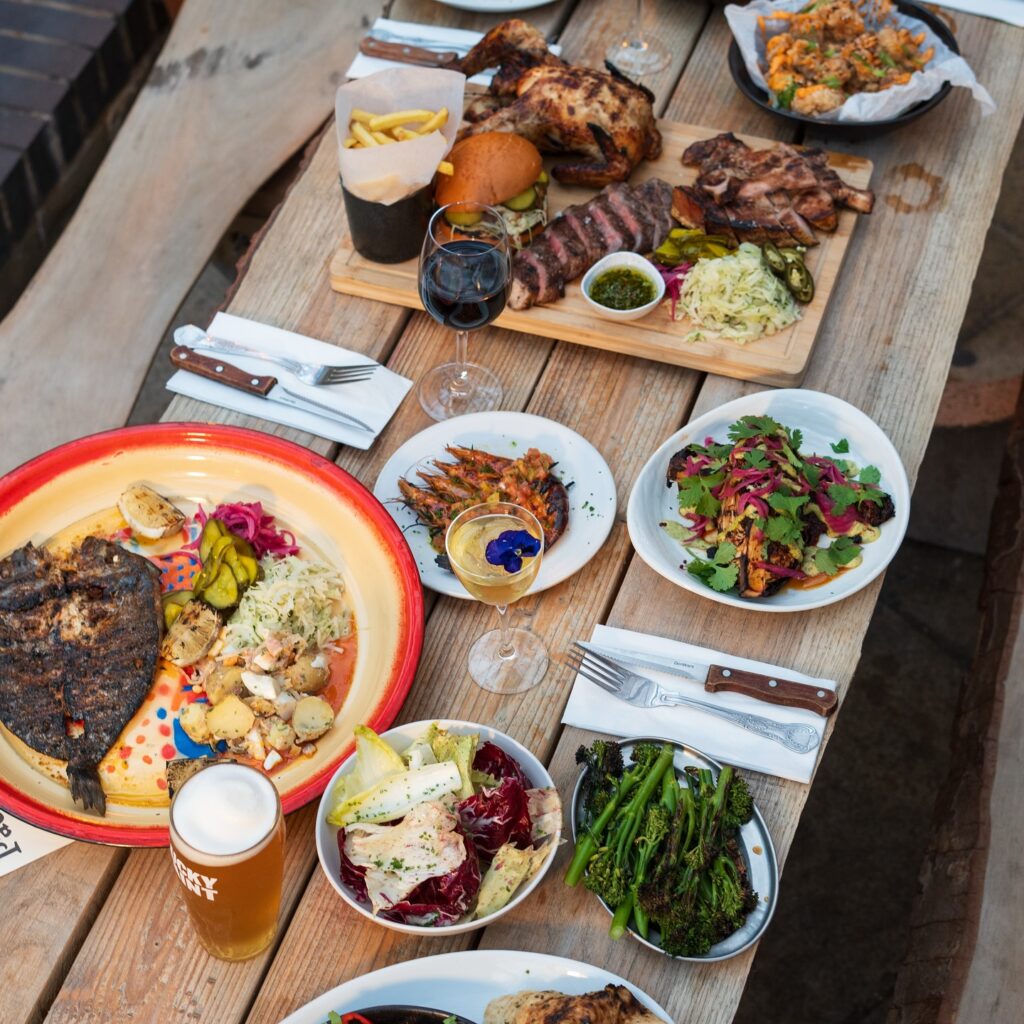

That seabream crudo, incidentally, is a thing of beauty: translucent slices of fish barely kissed with citrus and chilli, the coconut milk adding richness without overwhelming the delicate fish. At £13, it’s not cheap for what amounts to six slices of raw fish, but it’s a transportive dish that’ll have you on a beach somewhere at the first bite. As Frank Ocean once said, that’s a cheap vacation, although he was talking about spliff to be fair.
The space itself used to be the Quebec Curve pub, and before that a Vietnamese restaurant that we miss but we never caught the name of. Now it’s all sage green paint and botanical prints, with enough plants to stock a garden centre. On busy nights, the noise levels can reach nightclub proportions, but we guess that’s the point. This isn’t somewhere for intimate conversation; it’s somewhere to drink frozen margaritas and eat fish tacos while pretending you’re somewhere else.
When you do finally decide to leave and you’re confronted with a car park and a Gala Bingo, it can be a little jarring, we have to admit. It’s enough to make you turn on your heel and order another round of those margs.
Website: pacifictavern.co.uk
Address: 100 Redriff Rd, London SE16 7LH
Bone Daddies, Old Jamaica Road
Ideal for when you need ramen and rock’n’roll…
The Bermondsey Beer Mile might be a 15-minute walk from Canada Water, but when you get that very specific craving for tonkotsu ramen that hits us all every few months, you make the pilgrimage. Housed in a railway arch that shakes, rattles and rolls every time a train passes overhead, Bone Daddies leans into the challenging building (it’s fine really, we just need an angle), meeting it with massive flavour and thumping tunes.

The atmosphere hits you first: music loud enough to sterilise equipment, communal benches packed with people slurping noodles like their lives depend on it, and steam billowing from the open kitchen where cooks who look about 12 years old work with real focus. This is not a place for intimate conversation or dietary restrictions. This is a place for pork fat and jammy, obscenely umami-laden eggs.
Their signature Tonkotsu is a beautiful thing; a bowl of cloudy, ivory-coloured broth that’s been simmered for 20 hours until it’s achieved the consistency of liquid silk. The chashu pork belly melts on contact with your tongue, the ajitama egg oozes golden yolk into the soup, and the noodles have just enough bite. They’re made fresh each morning, and it shows.
Yes, you’ll leave smelling of pork fat. Yes, your ears will ring for an hour afterwards. No, you won’t care.
Website: bonedaddies.com
Address: 27-28, Old Jamaica Business Estate, 24 Old Jamaica Rd, London SE16 4AW
Read: The best ramen in London
Pizarro, Bermondsey Street
Ideal for a rowdy, sherry-soaked Spanish feast…
Chef José Pizarro could probably open a restaurant serving nothing but jamón ibérico and olive oil and we’d still queue round the block. Fortunately, his eponymous Bermondsey Street restaurant offers rather more than that, though the jamón is indeed spectacular and you should absolutely start with it.
Pizarro (the restaurant, not the conquistador) occupies a corner site that catches the afternoon sun beautifully, which is handy because you’ll want to linger here after your lunch, potentially on into dinner. The menu changes daily based on what’s in season, but certain dishes have achieved permanent status through popular demand. The croquetas, for instance, change filling regularly but maintain a consistency that’s crispy outside and molten within, causing third-degree burns to impatient diners since 2011. And causing diners to become inpatients occasionally too…
It’s not all tapas (or ‘pica pica’, as they’re referred to here). Pizarro excels at the larger sharing plates too, whether that’s suckling lamb leg with lettuce and honey, or roast cod with potato rosti and parsley oil. Whatever you go for, there’s a certain trust in anything chef José Pizarro does; you just know that good ingredients will have been cooked with respect and seasoned judiciously, and sometimes, that’s all you really want from your lunch, right?

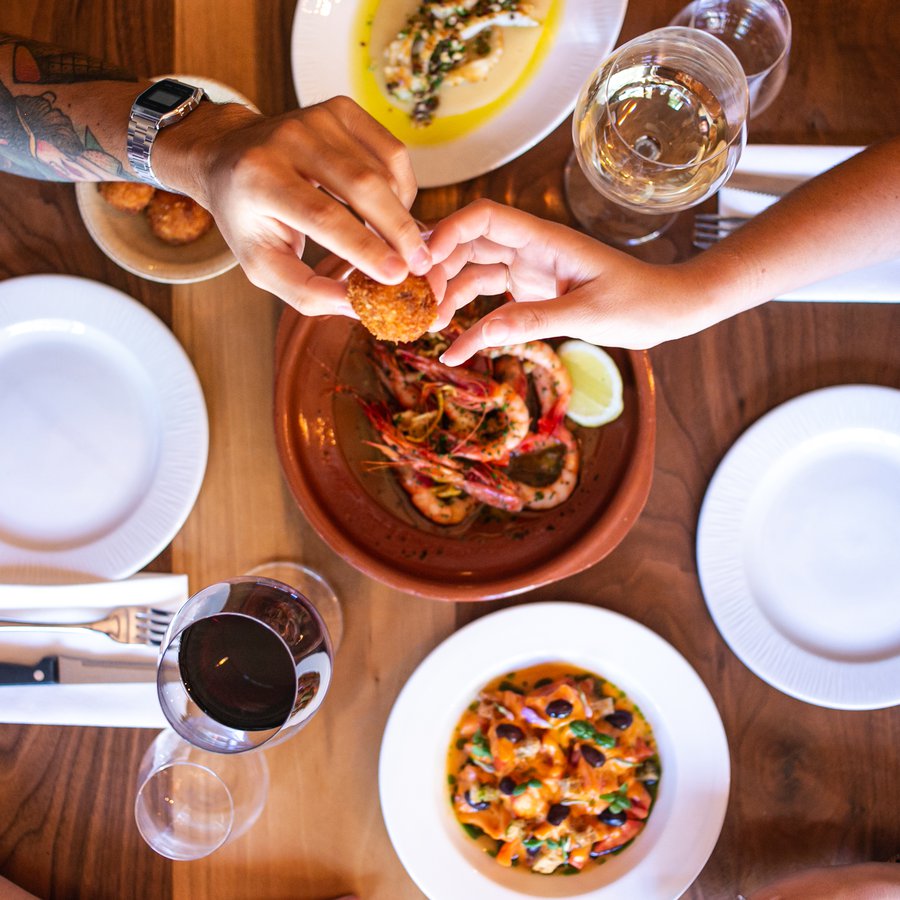
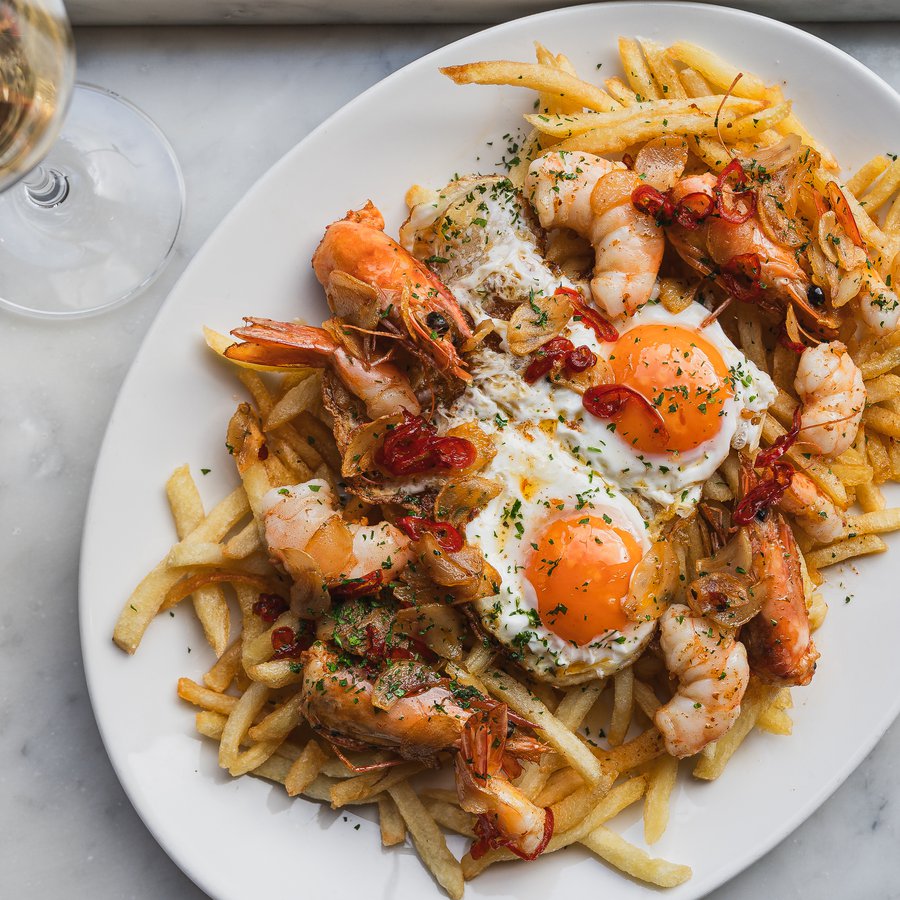
Then there’s the legendary wild prawns in garlic oil, fried eggs and triple-cooked chips, which is a glorious tangle of surprising precision. The prawns are sweet and plump, the egg is slow-cooked at exactly 63 degrees until the white is just set and the yolk flows like lava, and the chips have been through more processes than a visa application but emerge perfect: crispy, thin but fluffy, and utterly addictive.
There’s a feeling in here that makes you want to order with total abandon, and the entirely Spanish wine list (starting at £34 a bottle) won’t help your restraint. The atmosphere can get pretty raucous, especially when the after-work crowd descends, but the staff handle it all with good humour and surprising efficiency. José himself sometimes appears, usually to deliver plates personally to regulars, making everyone else feel slightly inadequate, it must be said (note to self; must become a regular).
Dog-friendly, child-tolerant, and open seven days a week, Pizarro is that rare thing: a restaurant that works equally well for dates, family dinners, or solo tapas at the bar. And, if you do find Pizarro full, the chef’s more laid back (but equally rammed) tapas bar José is just next door. You might get lucky with a walk-in!
Website: josepizarro.com
Address: 194 Bermondsey St, London SE1 3TQ
Read: Where to eat on Bermondsey Street
Corner Corner, Maritime Street
Ideal for grazing your way through London’s most ambitious food hall…
When Corner Corner opened in April 2025, Canada Water, as a budding, ambitious new neighbourhood of sorts, finally got the food hall it deserved. This isn’t some half-hearted collection of chains in a shopping centre; this is 55,000 square feet of culinary ambition, complete with London’s largest indoor vertical farm growing actual lettuce and herbs on site.
The lineup includes serious players: Chick N Sours brings its hot mess chicken burgers south of the river for the first time, Jou Jou’s Bites does Taiwanese street food with the volume turned up to eleven, and Sireli serves Armenian comfort food of real quality, the lamb kofte with whipped feta, pickles and hummus is outstanding. We have to confess that we haven’t tried the fourth and final food offering here, Masa Tacos, but we’ve heard good things.
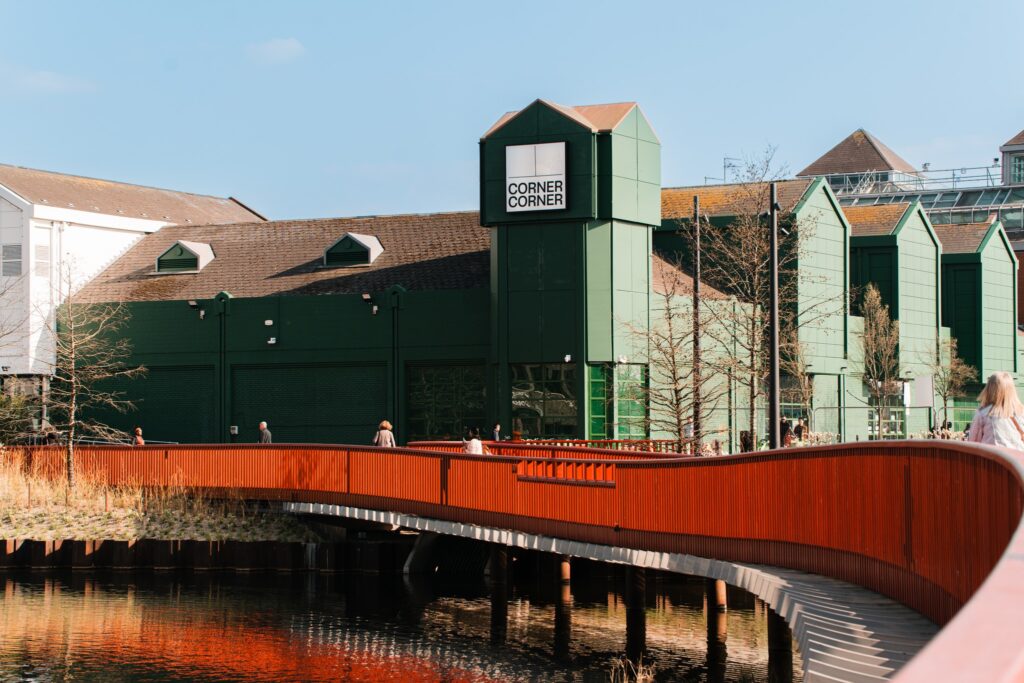




That vertical farm isn’t just for show. The microgreens and salad leaves travel approximately 50 feet from growing tower to plate, which must be some kind of record. For a food hall, at least. Watching someone harvest your salad garnish while you wait for your food feels simultaneously futuristic and weirdly primitive, like we’ve gone full circle back to picking vegetables from the garden as and when it’s needed.
There’s a jazz club downstairs that has made Corner Corner something of a focal point of nights out in the area, and locals get 10% off everything if they can prove they live in SE16. It’s this kind of community thinking that stops food halls feeling like soulless tourist traps. Which is, we should say, increasingly the case in London and beyond…
The food hall operates Thursday to Sunday (with the café section open daily), which seems limiting until you realise it means everything’s fresh and the vendors actually get some time off. Revolutionary concept, that.
Speaking of which, we’re off for a well-earned break, too. Enjoy!
Website: cornercorner.com
Address: Maritime St, London SE16 7LL

